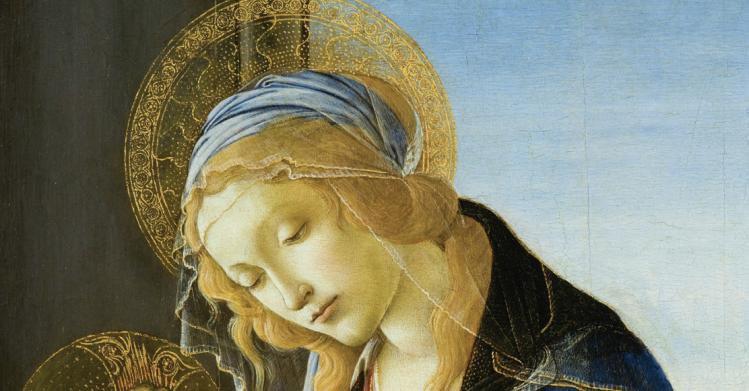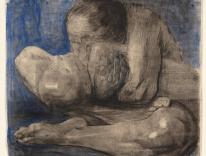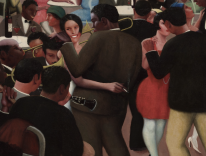
The most beautiful portrayal of Marian devotion I’ve seen in literature came unexpectedly in New York Times columnist David Carr’s 2009 addiction memoir, The Night of the Gun: A Reporter Investigates the Darkest Story of His Life—His Own. Carr, finally drug-free and sober, had been been diagnosed with Hodgkin’s lymphoma; the treatments left him too weak to move, and he resorted to giving his three-year-old daughter Meagan cash for the pizza guy so they could eat.
“Keep the change,” I’d hear her say per my instructions to some stunned guy who probably took the story back to the shop. On nights when I was too tired to tuck them in, I would lie there and hear her tell [her sister] Erin it was time to say prayers before bed.
“Lovely lady, dressed in blue, teach me how to pray...”
Mary has had so many titles, from the lyrical “Star of the Sea” to the martial “Exterminatrix of Heresies.” There’s a Mary for every mood. Mary champions the oppressed and heralds the overturning of the social order (“He has thrown down the rulers from their thrones but lifted up the lowly”). She guides philosophy and, by her intercessory prayers, undoes the impossible knots of our lives.
“Picturing Mary: Woman, Mother, Idea,” at the National Museum of Women in the Arts in Washington, D.C., through April 12, 2015, pulls together an impressive collection of paintings, sculptures, and liturgical vestments in order to suggest the wide range of Marian images in Western art. The show includes works by Michelangelo, Fra Filippo Lippi, Caravaggio, Artemisia Gentileschi, Botticelli, Rembrandt, and Dürer. It shows Mary as Seat of Wisdom; Mary as Mother of Mercy, sheltering little kneeling penitents under her golden cloak; and Mary as Queen of Heaven with the serpent trampled underfoot. But by far the most common attribute on display in this show, just as in Carr’s children’s prayer, is Mary’s tenderness: she is portrayed as the ordinary mother of an extraordinary son.
The exhibition is well designed. It’s limited: “Western art” turns out to mean mostly Italian with some French and Low Countries, from about the fourteenth through the nineteenth centuries. The wall captions spell out the nuances of doctrine, making the exhibit accessible to people who have no idea what the Assumption is. There are some bobbles. One weird caption describes a chasuble as “a large, sleeveless garment worn by priests as they say the Eucharist, or ‘Mass.’” But most of the captions make sense. The walls have been painted in rich tones of turquoise, blue, and purple, which not only highlight the artwork but subtly recall Mary’s blue robes and the purple robes of priests. The walls are inscribed with passages from classic Marian texts, including the Divine Comedy and the Litany of Loreto. These weave the images into a fabric of devotion and prayer.
Here, Mary rarely looks directly at the viewer. Sometimes she looks down in apprehension or sorrow; occasionally she looks up to heaven in ecstasy; most often she looks at her child. Elisabetta Siriani’s 1663 Virgin and Child shows a Christ one can only call adorable, as he crowns his mother with a garland of roses. She holds him protectively, and bows her head to receive the crown.
Although the captions note that Mary’s image gets more down-to-earth during the Renaissance, even much earlier depictions show Jesus interacting with her like any other baby with his mom. He’s shown burrowing toward her breast, ready to nurse, in a pose familiar to all mothers. A painting by Artemisia Gentileschi presents a focused, watchful Mary and a Christ child who is completely intent on her nursing breast. The two appear in humble surroundings. Mary’s own clothing is a rich Renaissance pink, but we also see rough linen, simple wooden furniture, and bare feet.
Emphasizing Mary’s humanity was often a way to emphasize the humanity of Christ. The Madonna and Child portrait by the “Master of the Winking Eyes” (the eyes are in fact quite odd) has Mary draping her veil over her baby’s head as well as her own, signifying that she—like all of us—shares a common human nature with Christ. Sandro Botticelli’s luminous Madonna of the Book poses the baby Jesus between Mary and the text, reminding the viewer—as the caption notes—that he is the Word made flesh.
Almost all these portrayals, even the gentlest, include hints that foreshadow the Crucifixion. These can be subtle and symbolic (a lamb or a pelican) or more obvious (a sarcophagus or even a tiny cross held by the infant John the Baptist). The infant Jesus is often portrayed asleep, and this too can be interpreted as a prefiguration of his death. There are also two rooms devoted to images of the Crucifixion, one of them entirely given over to a huge painting by Giorgio Vasari. On the wall opposite this Crucifixion scene is inscribed the opening of the “Stabat Mater.” Francescuccio Ghissi’s The Dead Christ and Angels; Adoration of the Infant Jesus pairs the two ends of Jesus’ life. The brilliant tempera-and-gold painting shows two different ways of reigning from within helplessness: the infant’s prone body streams with light, as blood streams from the palms of Jesus’ dead body, still nailed to the Cross.
Among the most powerful depictions of the Crucifixion in this show is the Master of Sant’Anastasia’s horrifying fourteenth-century stone sculpture. Jesus’ neck hangs at an impossible, broken angle. Ropes of muscle stand out on his thin, racked arms. His mother pleads at his feet, while a skull beneath the Cross seems to laugh and St. John the Evangelist looks away in anguish. The sculptor even carved the lines of pain between Mary’s knitted brows. The big, blunt, shovel-shaped faces make the scene somehow even sadder: there’s no prettiness to distract from the sordid misery.
It’s easy to identify with Mary in both the Crucifixion scenes and the images of the Madonna and Child. Many of us have felt anguish as we helplessly watch a suffering and dying loved one. Many of us have felt the mixture of joy, need, and care of a mother cradling her infant. Mary and Jesus entered into the most common experiences of human life: the exhaustion, the worry, the intimate tenderness, the cheap clothes and bare feet; the humiliation, powerlessness, sorrow, and love.
But these most relatable moments in Mary’s life aren’t the whole story. Angelo Pellegrini’s silver sculpture Immaculate Conception and Symbols of the Evangelists, right at the entrance to the exhibit, shows a Mary much harder to identify with: a glinting celestial queen. The reason she has commanded so much attention over the centuries isn’t just that she and her son are like us (although they are). They are also different. He is not solely a man suffering on a cross, but also the glorified Son of God who rose from the dead with his wounds still visible. She is not solely a mother comforting her child, but the Queen of Heaven. She can guide our troubled lives because her own was immaculate. Because she is more than solely a parent, she can guide children in a way even their own parents can’t. She’s the lovely lady in the blue dress—and the one who teaches us to pray.
Please email comments to [email protected] and join the conversation on our Facebook page.
Previous Story
How Jesus Became God
Next Story
Fr. Richard McBrien, R.I.P.


